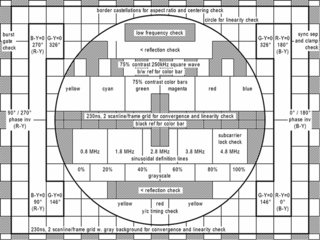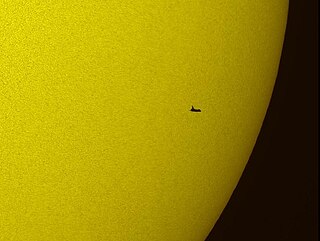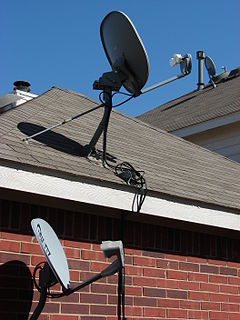
A communications satellite is an artificial satellite that relays and amplifies radio telecommunications signals via a transponder; it creates a communication channel between a source transmitter and a receiver at different locations on Earth. Communications satellites are used for television, telephone, radio, internet, and military applications. There are about 2,000 communications satellites in Earth's orbit, used by both private and government organizations. Many are in geostationary orbit 22,236 miles (35,785 km) above the equator, so that the satellite appears stationary at the same point in the sky, so the satellite dish antennas of ground stations can be aimed permanently at that spot and do not have to move to track it.
Television receive-only (TVRO) is a term used chiefly in North America to refer to the reception of satellite television from FSS-type satellites, generally on C-band analog; free-to-air and unconnected to a commercial DBS provider. TVRO was the main means of consumer satellite reception in the United States and Canada until the mid-1990s with the arrival of direct-broadcast satellite television services such as PrimeStar, USSB, Bell Satellite TV, DirecTV, Dish Network, Sky TV that transmit Ku signals. While these services are at least theoretically based on open standards, the majority of services are encrypted and require proprietary decoder hardware. TVRO systems relied on feeds being transmitted unencrypted and using open standards, which heavily contrasts to DBS systems in the region.

A satellite dish is a dish-shaped type of parabolic antenna designed to receive or transmit information by radio waves to or from a communication satellite. The term most commonly means a dish used by consumers to receive direct-broadcast satellite television from a direct broadcast satellite in geostationary orbit.

A parabolic antenna is an antenna that uses a parabolic reflector, a curved surface with the cross-sectional shape of a parabola, to direct the radio waves. The most common form is shaped like a dish and is popularly called a dish antenna or parabolic dish. The main advantage of a parabolic antenna is that it has high directivity. It functions similarly to a searchlight or flashlight reflector to direct the radio waves in a narrow beam, or receive radio waves from one particular direction only. Parabolic antennas have some of the highest gains, meaning that they can produce the narrowest beamwidths, of any antenna type. In order to achieve narrow beamwidths, the parabolic reflector must be much larger than the wavelength of the radio waves used, so parabolic antennas are used in the high frequency part of the radio spectrum, at UHF and microwave (SHF) frequencies, at which the wavelengths are small enough that conveniently-sized reflectors can be used.
A broadcast range is the service area that a broadcast station or other transmission covers via radio waves. It is generally the area in which a station's signal strength is sufficient for most receivers to decode it. However, this also depends on interference from other stations.

Amateur television (ATV) is the transmission of broadcast quality video and audio over the wide range of frequencies of radio waves allocated for radio amateur (Ham) use. ATV is used for non-commercial experimentation, pleasure, and public service events. Ham TV stations were on the air in many cities before commercial television stations came on the air. Various transmission standards are used, these include the broadcast transmission standards of NTSC in North America and Japan, and PAL or SECAM elsewhere, utilizing the full refresh rates of those standards. ATV includes the study of building of such transmitters and receivers, and the study of radio propagation of signals travelling between transmitting and receiving stations.
Free-to-air (FTA) services are television (TV) and radio services broadcast in clear (unencrypted) form, allowing any person with the appropriate receiving equipment to receive the signal and view or listen to the content without requiring a subscription, other ongoing cost, or one-off fee. In the traditional sense, this is carried on terrestrial radio signals and received with an antenna.
A block error is a common type of error in certain types of digital television transmission, particularly those that use image compression. Its presence in a television image is a telltale sign that 1) the signal is broadcast digitally, as this type of error can not occur in analog transmission, and 2) that there is a significant amount of noise, as digital television is designed to tolerate a certain amount of interference. Block errors are usually detected, but not corrected, by the receiving device and are commonly displayed as empty black boxes in the television image.

Electromagnetic interference (EMI), also called radio-frequency interference (RFI) when in the radio frequency spectrum, is a disturbance generated by an external source that affects an electrical circuit by electromagnetic induction, electrostatic coupling, or conduction. The disturbance may degrade the performance of the circuit or even stop it from functioning. In the case of a data path, these effects can range from an increase in error rate to a total loss of the data. Both man-made and natural sources generate changing electrical currents and voltages that can cause EMI: ignition systems, cellular network of mobile phones, lightning, solar flares, and auroras. EMI frequently affects AM radios. It can also affect mobile phones, FM radios, and televisions, as well as observations for radio astronomy and atmospheric science.

KTRE, virtual and VHF digital channel 9, is a dual ABC/Telemundo-affiliated television station licensed to Lufkin, Texas, United States and also serving Nacogdoches. The station is owned by Gray Television. KTRE's studios and transmitter are located on TV Road in the unincorporated community of Pollok.

A television antenna is an antenna specifically designed for use with a television receiver (TV) to receive over-the-air broadcast television signals from a television station. Terrestrial television is broadcast on frequencies from about 47 to 250 MHz in the very high frequency (VHF) band, and 470 to 960 MHz in the ultra high frequency (UHF) band in different countries. Television antennas are manufactured in two different types: "indoor" antennas, to be located on top of or next to the television set, and "outdoor" antennas, mounted on a mast on top of the owner's house. They can also be mounted in a loft or attic, where the dry conditions and increased elevation are advantageous for reception and antenna longevity. Outdoor antennas are more expensive and difficult to install, but are necessary for adequate reception in fringe areas far from television stations. The most common types of indoor antennas are the dipole and loop antennas, and for outdoor antennas the yagi, log periodic, and for UHF channels the multi-bay reflective array antenna.

WXGA-TV, virtual channel 8, is a Public Broadcasting Service (PBS) member television station serving Valdosta, Georgia, United States that is licensed to Waycross. Owned by the Georgia Public Telecommunications Commission, it is a sister station to National Public Radio (NPR) member WXVS. WXGA-TV's transmitter is located on TV Tower Road in unincorporated Ware County. The station is operated as part of the statewide Georgia Public Broadcasting (GPB) television network.

In astronomy, a solar transit is a movement of any object passing between the Sun and the Earth. This mainly includes the planets Mercury and Venus. A solar eclipse is also a solar transit of the Moon, but technically only if it does not cover the entire disc of the Sun, as "transit" counts only objects that are smaller than what they are passing in front of. Solar transit is only one of several types of astronomical transit.
Satellite television is a service that delivers television programming to viewers by relaying it from a communications satellite orbiting the Earth directly to the viewer's location. The signals are received via an outdoor parabolic antenna commonly referred to as a satellite dish and a low-noise block downconverter.

A free-to-air or FTA Receiver is a satellite television receiver designed to receive unencrypted broadcasts. Modern decoders are typically compliant with the MPEG-2/DVB-S and more recently the MPEG-4/DVB-S2 standard for digital television, while older FTA receivers relied on analog satellite transmissions which have declined rapidly in recent years.

Radio is the technology of signaling and communicating using radio waves. Radio waves are electromagnetic waves of frequency between 30 hertz (Hz) and 300 gigahertz (GHz). They are generated by an electronic device called a transmitter connected to an antenna which radiates the waves, and received by a radio receiver connected to another antenna. Radio is very widely used in modern technology, in radio communication, radar, radio navigation, remote control, remote sensing and other applications.
KNMD-TV, virtual channel 9, is a World-affiliated television station serving Albuquerque, New Mexico, United States that is licensed to Santa Fe. The station is owned by the University of New Mexico, making it the sister station of KNME-TV.

Currently, there are three primary satellite television providers of subscription based service available to United States consumers: DirecTV, Dish Network and Orby TV, which have 21 and 10 million subscribers respectively.

Dish México, S. de R. L. de C.V. is a Mexican-owned company that operates a subscription satellite television service in Mexico nationwide. S. de R. L. de C.V. stands for Sociedad de Responsabilidad Limitada de Capital Variable, a form of limited company. It is owned by MVS Comunicaciones (51%) and Dish Network Corporation (49%).
WETP-TV, virtual channel 2, is a Public Broadcasting Service (PBS) member television station licensed to Sneedville, Tennessee, United States. The station is owned by the East Tennessee Public Communications Corporation. WETP-TV's transmitter is located atop Short Mountain near Mooresburg, Tennessee.












